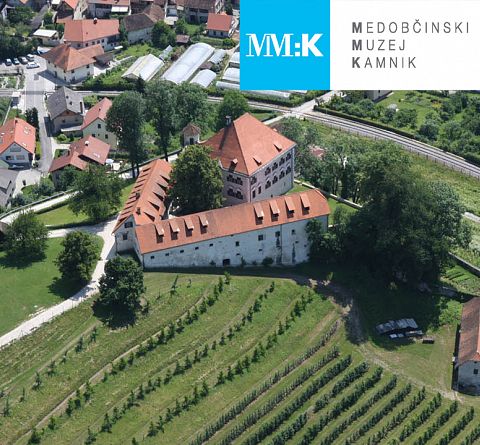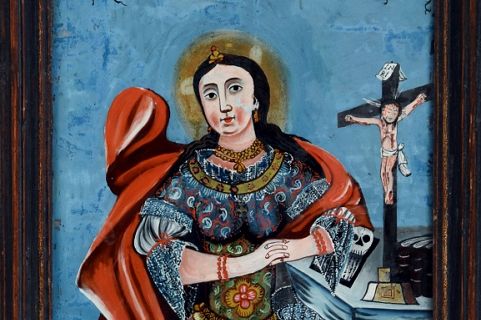Mary Magdalene, painting on glass, 1792
The painting on the glass depicts St. Mary Magdalene in a rich Baroque outfit – in an embroidered and lace dress, draped in a red cloak. She has jewellery in her hair, as well as rich jewellery, earrings, a necklace and bracelets. In a kneeling position, she prays in front of the altar with the crucified Jesus. The altar is also decorated with a lace tablecloth. The background is blue and above is the inscription 17 Maria: Magdalena 92.
Paintings on glass from such an early period, that is, the 18th century, are quite rare. In Slovenia, in the 18th century, they were only available in noble and burgher houses. From the beginning of the 19th century, they also had them in peasant homes. The motifs were mostly religious, i.e. scenes from the Bible and saints. Of the saints, the following are ‘more strongly’ represented: Sts. Anna with Mary, St. Catherine, St. Magdalena, The Annunciation of Mary, The Coronation of Mary, sv. Three kings.
Initially, paintings on glass were imported. The most famous workshops were in Bavaria, in the Czech Woods (Pohoří) and in Sandl in Upper Austria, which peaked in the first third of the 19th century. “Pictures from Sandla” carried the reputation of this village throughout the Habsburg monarchy. They produced them in large quantities and exported them to foreign countries, including Slovenian territory. They were brought to us by traveling merchants, and people bought them at fairs. They were also made by local masters in Slovenia. Art historian dr. Gorazd Makarovič, according to the typology of painting on glass with Slovene inscriptions, attributed it to two folk painters and one painting workshop: the Master of Clumsy Drawing, the Master of Small Figures and the Selce Workshop from Selce in the Selška Valley.
Images on glass are made by a special process. The painting base and at the same time the protection of the coloured layer is glass. The order of painting is reversed as in normal painting. The painter first painted the details and the basic drawing on the back of the glass base, then proceeded to paint the larger coloured surfaces. The front, visible side of the image is thus a mirror image




